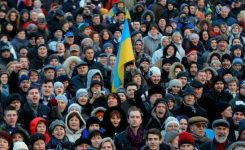E-News, climate change, In Evidenza, Ultime Notizie, Notizie
Bonaccini: “armonizzare i fondi per visione strategica. No a dispersioni”
“La grande opportunità dei fondi europei va percorsa e determinerà un giudizio sulla classe dirigente”. Lo ha detto il primo ottobre Stefano Bonaccini, presidente della Regione Emilia-Romagna, del CEMR e dell’AICCRE, all’inizio del suo intervento nel convegno “Il ruolo dei territori nei programmi di lungo termine e nelle politiche di sostenibilità”, nell’ambito del Festival dello Sviluppo Sostenibile 2020, che ha affrontato il tema del contributo di Regioni, Province e Città di fronte alla sfida dei fondi europei.
“Il green new deal, ha continuato Bonaccini, indica molto bene le priorità per rimettere in moto una crescitache però deve essere sostenibil ee lo dobbiamo fare con un occhio agli obiettivi indicati dall’Onu, con infrastrutture materiali sostenibili e immateriali come la digitalizzazione. Abbiamo bisogno di alcuni filoni strategici per realizzare la società della conoscenza: un sistema di welfare e di sviluppo sostenibile e di sanità pubblica”. Gli enti locali e regionali hanno preteso di essere coinvolte e abbiamo alcune settimane per indicare insieme le priorità.
“Anche le Regioni devono fare alcune scelte strategiche evitando un’enciclopedia di singoli piccoli progetti utili a prendere più voti alle elezioni invece di consegnare una prospettiva che valga per i prossimi dieci o vent’anni, recuperando i ritardi storici che le regioni hanno accumulato”, ha affermato il Presidente.
“È necessario ridurre i divari tra i più forti e i più deboli, ma nessun governo senza le Regioni e i Comuni ce la farebbe a realizzare oltre 200 miliardi di progetti.
È necessaria una programmazione integrata di tutti questi aspetti, anche perché la tempistica dei fondi europei impone decisioni rapide che non sempre le Regioni sono in grado di rispettare”.
“In Emilia – Romagna indicheremo un piano per il lavoro e per il clima programmando il settennato sia per i fondi europei che per i fondi nazionali, ma guardando al 2030”.

Bonaccini poi ha parlato anche da Presidente del CEMR attraverso il quale “abbiamo chiesto ai governi di tenere insieme le opportunità offerte dai vari recovery fund, dai governi nazionali e le programmazioni delle regioni. Serve una robusta cabina di regia, compito che il governo deve mettere in campo, d’intesa con i governi locali e con l’Europa che eviti la dispersione e sovrapposizione di progetti, per ottenere quindi una linearità ancora migliore di quella che immaginiamo”.
English version
“The great opportunity of the European funds must be taken and will determine a judgment on the ruling class”. Stefano Bonaccini, President of the Emilia-Romagna Region, CEMR and AICCRE, said this on October 1 at the beginning of his speech at the conference “The role of territories in long-term programs and sustainability policies”, within the Festival of Sustainable Development 2020, which addressed the theme of the contribution of Regions, Provinces and Cities to the challenge of European funds.
“The green new deal, continued Bonaccini, indicates very well the priorities to start a growth that must be sustainable and we must do it with an eye to the objectives set by the UN, with sustainable and intangible material infrastructure such as digitization. We need some strategic strands to achieve the knowledge society: a system of welfare and sustainable development and public health”. Local and regional authorities pretended to be involved and we have a few weeks to indicate the priorities together.
“Even the Regions must make some strategic choices avoiding an encyclopedia of single small projects useful to take more votes in the elections instead of delivering a perspective that will be valid for the next ten or twenty years, making up the historical delays that the regions have accumulated,” said the President.
“It is necessary to reduce the gaps between the strongest and the weakest, but no government without the Regions and Municipalities would be able to realize more than 200 billion projects.
An integrated planning of all these aspects is necessary, also because the timing of European funds requires rapid decisions that the Regions are not always able to respect”. “In Emilia – Romagna we will indicate a plan for the work and the climate by programming the seven-year period for both European and national funds, but looking at 2030”.
Bonaccini then also spoke as President of CEMR through which “we have asked governments to keep together the opportunities offered by the various recovery funds, national governments and the programming of the regions. We need a strong control room, a task that the government must put in place, in agreement with local governments and Europe that avoids the dispersion and overlapping of projects, to achieve a linearity even better than we imagine”.








